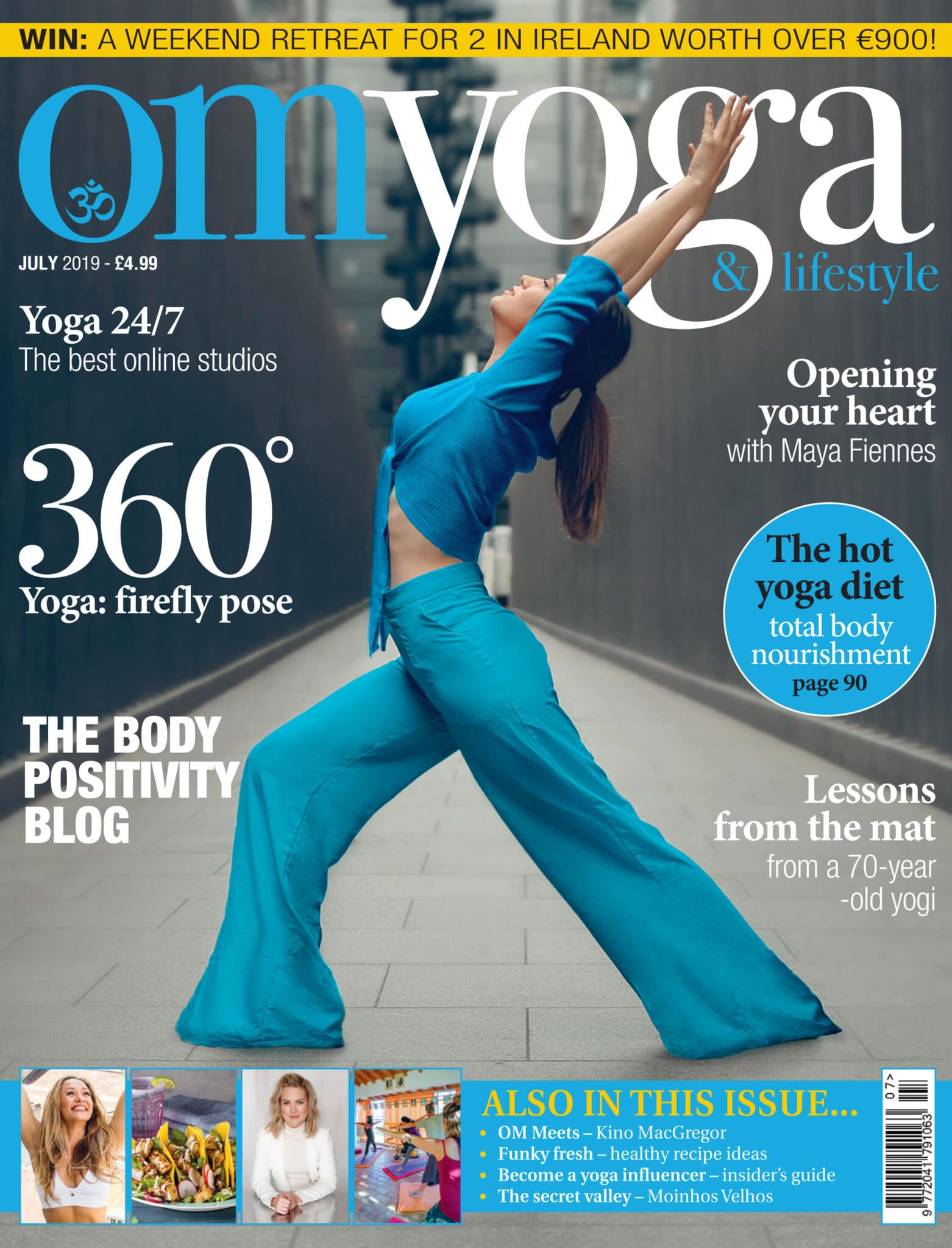
Yoga Nidra: a homecoming and a release
Uma Dinsmore-Tuli explores the power and potential of one of yoga’s simplest but most effective tools.
Literally, Yoga Nidra means ‘yoga sleep ’and it is an astonishing, accessible and totally effortless yoga practice that anyone can do, by ourselves, in a class, in a one-to-one yoga or therapy session, or by using audio recordings. Yoga Nidra is usually done lying down and does not involve any physical movement. It promotes deep healing and very profound rest at every level of being: physical, energetic, mental, emotional and intuitive. It does this because it works systematically through each aspect of our human being: first, establishing deep physical rest that allows for recuperation and the restoration of our body to a state of homeostasis, or balance at a biochemical level.
Since Yoga Nidra promotes our body’s natural tendency towards homeostasis, it enables those systems of the body which are often out of sync or disturbed to move towards optimum balance and cyclical functioning.
Once the opening stages of Yoga Nidra enable our bodies to relax and function optimally, then we are able to restore vitality and emotional stability. The combination of deep physical rest, revitalisation and the settling of emotions and thoughts can result in improved productivity, heightened intelligence, enhanced creativity and an openness to guidance, wisdom and insight. Thus Yoga Nidra is effective in the relief of insomnia, anxiety, depression, panic attacks and other stress-related problems. Yoga Nidra is also helpful in the management of chronic and acute pain, the treatment of infertility, to relieve menstrual cramps, and pre-menstrual tension, and as a tool for self-enquiry. There is evidence from colleagues around the world of the efficacy of Yoga Nidra in relieving symptoms of Parkinson’s disease, in the management of addictions, in the treatment of posttraumatic stress disorder, and as a powerful tool in palliative care.
The meditative heart of yoga
The physical body comes into a state of extremely deep rest, whilst the mind is guided through various activities intended to induce the state of Yoga Nidra. It is a remarkable experience, a practice that invites us into a state of awareness that is utterly free and profoundly nourishing. It is both a homecoming and a release, a settling into the deepest layers of our true state of freedom. Richard Miller, the nondual psychotherapist whose development of Yoga Nidra in the US over the past 30 years has been very influential in ensuring global recognition of the power of this practice, calls it the meditative heart of yoga. Svami Satyananda, who first adapted and developed the practice to make it accessible for modern yogis, describes it as ‘aware sleep’. However you choose to define Yoga Nidra, it has an astonishing capacity to relieve mental and emotional tension, creating spaciousness to allow for authentic healing and transformation to occur.
Practicalities of practice
Yoga Nidra practices tend to be around 25 minutes long and vary in style, complexity and focus. The simplest Nidra may not contain any particular visualisations or imagery, while other practices may offer a short image to evoke an inner ritual of healing and connection. Some are based on more traditional rotations of consciousness than others and may have a specific focus or intention.
All methods of Yoga Nidra emphasise the importance of settling: for a deep practice it is crucial for the physical body to be so settled that there is no need for it to move. For this to happen the physical body needs to be comfortable. Here are some tips on how to achieve this:
- Create a secure and safe place where you will not be interrupted for the duration of the practice. Turn off phones and computers, dim lights, draw curtains or wear an eye pillow.
- Be well-propped. There is some debate about the relationship between restorative asana (asanas held passively, for a long time, with the use of props) and Yoga Nidra.
- Assume a comfortable lying position.
- Keep warm. Being cold is uncomfortable, put on warm socks and cover yourself with blankets.
- Move with awareness. Ideally in Yoga Nidra the body is so comfortable that there is no desire to move. If however, for whatever reason the desire for movement arises, then the best thing to do is to watch it. Often, it will pass. If it doesn’t, then that will probably be a sign that you really do need to move, so do so with awareness, with the intention to return to a state of settled stillness in which the body can rest.
“Yoga Nidra promotes deep healing and very profound rest at every level of being: physical, energetic, mental, emotional and intuitive.”
How old Is Yoga Nidra?
Recent scholarship has revealed that there are indeed ancient Indian roots to Yoga Nidra. But equally important are inspirations from western psychology dating from the late 19th century. There are in all three strands of influence, which intertwine to create the hybrid which is contemporary Yoga Nidra:
1. References in Indian epic poetry to Yoga Nidra, as a metaphor of the creative void.
2. Medieval hatha yoga manuals which refer to Yoga Nidra as a state of pure awareness.
3. 19th & 20th century western relaxationism and other psychotherapeutic practices. The structure of the practice Each of the practices of the three traditions introduced above – and indeed all contemporary schools of Yoga Nidra - has its own unique form .But all these forms are based on the same underlying structure, which includes these stages usually in this order:
1. PREPARATION: preparing for a beneficial practice can include restorative propping and a review of the issue being addressed.
2. SETTLING: this acts as a demarcation between the everyday state of consciousness and the state of Yoga Nidra. It may involve reference to elemental resonances to deepen the experience of ‘earthing’.
3. SANKALPA (RESOLUTION/RESOLVE): may be focused in the space of the heart which is identified as the location of the Yoga Nidra state of consciousness. It may also be preceded by an intention for the practice and/or the creation of a safe space.
4. ROTATION OF CONSCIOUSNESS: there are many different itineraries which can be used, each with its own rationale.
5. PAIRS OF OPPOSITES: there are many different levels and types, from the straightforward (e.g. heavy and light) to those used for specific aspects of psychological exploration or growth (e.g. confidence and confusion).
6. BREATHING/BODY FLOOR AWARENESS: bringing conscious attention to the breath deepens the connection with the experience of Yoga Nidra. Bringing awareness to the points of connection between body and floor can either serve to deepen the experience of Yoga Nidra, or it can serve as a reassuring reminder of the physicality of the body.
7. VISUALISATIONS: the purpose and nature of these depends upon the intention of the teacher and/or practitioner.
8. SANKALPA: repeated a second time to deepen the effect and connection.
9. EXTERNALISATION & RETURN TO ALERT STATE: often with a return to intention/safe place and/or invitation to carry the benefits of the practice into everyday life.
10. FINISH: The process of exiting from the state of Yoga Nidra is often as long as the process of entering into it.
So you can see that Yoga Nidra is designed to be a journey, one which starts and ends in the physical body, and in an everyday state of consciousness. Making the starting and ending point so clear, and so integral to the practice, means that Yoga Nidra is an inherently safe vessel in which to explore other aspects of the body-mind, and other states of consciousness.
SHARING THE POWER
The Yoga Nidra Network (yoganidranetwork.org) was set up by Uma Dinsmore-Tuli and Nirlipta Tuli, who together have over 40 years experience of practice, teaching and working therapeutically with all forms and levels of Yoga Nidra. It is an accessible hub for all things Yoga Nidra, a go-to resource for courses, workshops and events, the latest research and numerous and diverse free Nidras as downloadable audio tracks. The founders have also created Team Nidra, a collective of teachers from all traditions and lineages, working together to share Yoga Nidra with everyone everywhere.




